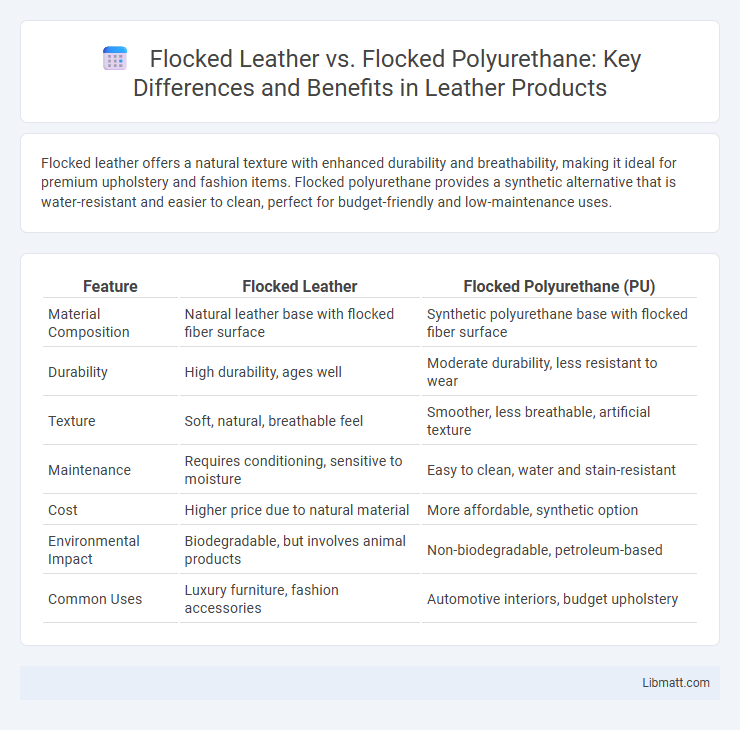Flocked leather offers a natural texture with enhanced durability and breathability, making it ideal for premium upholstery and fashion items. Flocked polyurethane provides a synthetic alternative that is water-resistant and easier to clean, perfect for budget-friendly and low-maintenance uses.
Table of Comparison
| Feature | Flocked Leather | Flocked Polyurethane (PU) |
|---|---|---|
| Material Composition | Natural leather base with flocked fiber surface | Synthetic polyurethane base with flocked fiber surface |
| Durability | High durability, ages well | Moderate durability, less resistant to wear |
| Texture | Soft, natural, breathable feel | Smoother, less breathable, artificial texture |
| Maintenance | Requires conditioning, sensitive to moisture | Easy to clean, water and stain-resistant |
| Cost | Higher price due to natural material | More affordable, synthetic option |
| Environmental Impact | Biodegradable, but involves animal products | Non-biodegradable, petroleum-based |
| Common Uses | Luxury furniture, fashion accessories | Automotive interiors, budget upholstery |
Understanding Flocked Leather
Flocked leather features a natural leather base coated with tiny fiber particles that create a soft, velvety texture distinct from synthetic materials. This method enhances breathability and durability by combining genuine leather's toughness with a plush surface finish, unlike flocked polyurethane, which uses a synthetic base that lacks the same aging qualities. Understanding flocked leather involves recognizing its unique combination of natural fiber adherence and leather's inherent strength, offering superior comfort and longevity.
What is Flocked Polyurethane?
Flocked polyurethane is a synthetic material made by applying short fibers onto a polyurethane base through an electrostatic or adhesive process, creating a soft, velvet-like texture. This coating enhances grip, durability, and aesthetic appeal compared to smooth surfaces, making it popular in automotive interiors, footwear, and upholstery. Unlike flocked leather, which uses natural animal hide, flocked polyurethane offers greater resistance to moisture and easier maintenance while mimicking the look and feel of suede or velvet.
Key Differences Between Flocked Leather and Flocked Polyurethane
Flocked leather features a natural leather base with fibers adhered to its surface, offering genuine texture and breathability, while flocked polyurethane uses a synthetic polymer base coated with fiber particles, providing enhanced water resistance and durability. Key differences include the origin of the material--animal hide versus man-made polyurethane--and their maintenance requirements, where flocked leather demands more care to preserve softness, whereas flocked polyurethane is easier to clean and more resistant to wear and tear. Your choice between these materials should consider factors like comfort, environmental impact, and intended use, as flocked leather provides authentic luxury and aging qualities, while flocked polyurethane excels in versatility and affordability.
Material Composition and Manufacturing Process
Flocked leather is created by applying tiny fibers onto a leather base using an adhesive, resulting in a textured, suede-like surface, whereas flocked polyurethane involves bonding fibers to a synthetic PU layer, providing durability with a similar tactile finish. The manufacturing of flocked leather starts with genuine leather treated through a flocking process, while flocked polyurethane is produced by coating a polyurethane substrate with adhesive before applying the fiber flock. Understanding these differences can help you choose between the natural feel of leather or the synthetic resilience of polyurethane for your specific application.
Durability and Lifespan Comparison
Flocked leather offers superior durability due to its natural hide base combined with a textured fiber finish, resulting in long-lasting wear resistance and a lifespan that can extend several years with proper care. Flocked polyurethane, while more affordable and resistant to water and stains, tends to have a shorter lifespan as the synthetic fibers may wear down or peel over time. In environments requiring heavy use, flocked leather maintains its integrity and appearance better than flocked polyurethane, making it a more durable option overall.
Aesthetic Appeal and Texture
Flocked leather offers a rich, natural texture with a matte finish that enhances the aesthetic appeal of luxury goods through its fine, velvety feel and breathable surface. Flocked polyurethane mimics this softness but tends to have a synthetic sheen and slightly less breathable texture, making it a more affordable and durable alternative. Your choice between the two depends on whether you prioritize authentic texture and elegance or cost-effective versatility and easy maintenance.
Cost Analysis: Flocked Leather vs Flocked Polyurethane
Flocked leather typically costs more than flocked polyurethane due to the natural material quality and labor-intensive production processes involved. Flocked polyurethane offers a budget-friendly alternative while still providing a similar textured finish, making it an attractive option for your projects requiring cost efficiency. Evaluating long-term durability and maintenance expenses is crucial for a comprehensive cost analysis between the two materials.
Environmental Impact and Sustainability
Flocked leather involves natural animal hides combined with synthetic flock fibers, which raises concerns about animal welfare and resource-intensive tanning processes that contribute to water pollution and high carbon emissions. Flocked polyurethane, a synthetic alternative, is derived from petrochemicals and relies on energy-intensive manufacturing, leading to non-biodegradable waste and microplastic pollution. Your environmentally conscious choice should weigh the biodegradability of natural leathers against the durability and potential recyclability of flocked polyurethane, considering industry advances in sustainable tanning and bio-based polyurethanes.
Common Applications and Uses
Flocked leather is commonly used in high-end fashion accessories, upholstery, and automotive interiors due to its luxurious texture and durability. Flocked polyurethane is frequently found in budget-friendly footwear, handbags, and sportswear for its water resistance and ease of maintenance. Both materials offer a suede-like appearance but serve different markets based on cost, performance, and aesthetic requirements.
Choosing the Right Material for Your Needs
Flocked leather offers a natural texture and breathability ideal for luxury upholstery and fashion applications, while flocked polyurethane provides enhanced durability, water resistance, and ease of maintenance suitable for high-traffic or outdoor use. The decision between flocked leather and flocked polyurethane depends on factors such as desired aesthetic, budget constraints, and performance requirements, with leather typically costing more but delivering superior comfort and aging characteristics. Understanding these material properties ensures selecting the right option for specific environments, balancing appearance, longevity, and functionality.
Flocked leather vs flocked polyurethane Infographic

 libmatt.com
libmatt.com